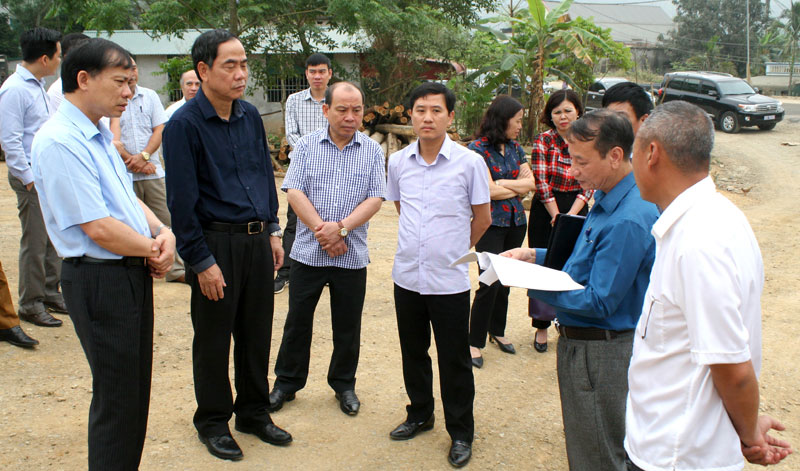
(HBO) – Deputy Secretary of the Hoa Binh provincial Party Committee and Chairman of the provincial People’s Committee Nguyen Van Quang recently inspected the progress of the upgrading of Road 433, which links Hoa Binh city with Da Bac district. He was accompanied by Vice Chairman of the provincial People’s Committee Bui Van Khanh.

Chairman of the provincial People’s Committee Nguyen Van Quang examines
the sites of some households in May 4 hamlet which have not been handed over
land to the constructor.
The upgrade to the first 23km of Road 433 from
Hoa Binh city to Da Bac district is a key project of the province. It has total
investment of 988 billion VND (43.4 million USD) and began in late 2012. The
project is lagging behind schedule, so work on the Km 0 – Km 9+900 section has
to be extended to December 2018 due to difficulties in capital arrangement and
ground clearance. The slowness is also attributable to traverses complex
terrain, the big volume of construction work.
Listening to reports of the investor,
departments and local administrations, Chairman Quang said Road 433 plays a
crucial role in improving transport connectivity with mountainous communes of
Da Bac district.
However, after years of construction, the
project hasn’t been completed due to certain obstacles, he said, pointing out
the biggest problems in site clearance, resettlement of the displaced people,
and waste dumping site while the rainy season is coming and new problems could
appear.
He noted difficulties in capital sources have
been solved as the contractor pledged to use their own capital for construction.
To put the Km 0 – Km 9+900 section into use in
late 2018, he asked relevant agencies and local authorities to coordinate
closely with one another to address hindrances in site clearance in accordance
with legal regulations.
Regarding the sluggish building of the
resettlement area in Hoa Binh commune, he requested coordination be improved,
responsibilities of relevant agencies and authorities be clarified, and the
construction be accelerated to receive the displaced residents. Meanwhile, issues
related to the waste dumping site must be handled soon to ensure the site’s
sustainability, minimise problems that could arise and help the contractor to
complete the upgrade as schedule.
The provincial Chairman also called for measures
to reduce landslide risks and ensure safety for households in Toan Son commune
of Da Bac district. He assigned the working group of the provincial People’s
Committee Office to monitor the implementation of his instructions.
Hoa Binh province is undergoing a dynamic transformation amid Vietnam’s national digital transition. Building on Poliburo’s Resolution No. 57-NQ/TW on breakthroughs in science, technology, innovation, and national digital transformation, the province has rolled out a wide range of practical action plans. A standout initiative is the "Digital Literacy for All” movement, an effort to ensure that no one is left behind in the digital era.
Hoa Binh province is undergoing a dynamic transformation in the wake of the national digital transformation movement. Building on Resolution No. 57-NQ/TW of the Politburo on breakthroughs in science, technology, innovation, and national digital transformation, the province has implemented a wide range of practical action plans. A standout initiative is the "Digital Literacy for All” movement ambitious effort to ensure that no one is left behind in the digital age.
With a spirit of unity and proactive problem-solving, the Party Committee, the government and the people of Dong Lai Commune (Tan Lac District) have made great strides in implementing the resolutions of the 24th Party Congress of the commune for the 2020 - 2025 term. Focusing on leadership and practical actions, the commune has brought the Party’s resolutions into daily life, creating strong impacts and pushing the local development forward.
Amid the nationwide push for digital transformation, young people in Hoa Binh Province are stepping up as dynamic pioneers, applying technology to enhance Youth Union operations and expand the reach of youth-led initiatives. Through creativity and adaptability, Youth Union organizations at all levels have introduced a series of practical solutions, contributing to modern governance and community development.
In recent years, An Nghia commune, located in Lac Son district, has stepped up administrative reform, focusing on improving the quality and efficiency of its single-window service unit for receiving and processing administrative procedures. These improvements have helped create favourable conditions for local residents and organisations to handle administrative procedures, contributing to the commune’s broader socio-economic development.
The Prime Minister-approved master plan to develop the multi-use value of forests ecosystems through 2030, with a vision to 2050, aims to improve the management and sustainable use of forest resources, create jobs, increase incomes, and improve the living standards of ethnic minorities, people in mountainous and remote areas, forest workers and those living near forests.



